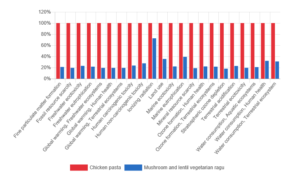
Dr. Holly is an Associate Professor in the Department of Environmental Science at UW-Green Bay and teaches in UW Extended Campus’s Master of Science in Sustainable Management (MSMGT) program. Sustainable Management was one of the first collaborative programs offered by UWEX and is still going strong as students seek a degree they can use to lessen our impact on the natural environment and improve our well-being.
In his course MSMGT 785, Waste Management and Resource Recovery, Dr. Holly includes what’s called a life cycle assessment (LCA) activity, which looks at the environmental impact of a product or service over its entire life. Because prospective students commonly asked whether LCA was taught in the program, MSMGT leadership decided it should be featured in a course. Since Dr. Holly’s course already discussed the theory of LCA, it seemed like a good fit for a practical component.
In Dr. Holly’s activity, students use open-source software and a free agricultural and food products database to perform an LCA of three different pasta recipes, two selected by the instructor and one of their choosing. They start out by comparing a chicken pasta recipe and a vegetarian mushroom and lentil ragu, then create their own entirely new recipe. In this spotlight, Dr. Holly gives us a more detailed look at the activity and its benefits for students.
Why is life cycle assessment so relevant today?
Dr. Holly calls LCA “a critical tool for sustainable managers to quantify the environmental impact of processes and products.” He explains this concept further in one of his course videos:
Over the past 20 years, life cycle assessment has grown from an academic exercise to an accepted decision-making tool for sustainable management. LCA is used by large companies and entire industries…to develop sustainable products and to quantify emissions and natural resource use to stakeholders and consumers…lifecycle inventories include thousands of calculations and require LCA software to complete. (MSMGT 785, Unit 3 Introduction)
What do students do in this activity and take away?
After going through a tutorial to learn about the software they will be using, students use “openLCA (a free life cycle assessment tool) to quantify the environmental impact of two defined recipes and one recipe of their choosing. Students then write a report discussing the environmental impacts of the recipes and assumptions used for analysis,” Dr. Holly explains.
Student feedback on the activity has been positive. They see it as relevant to their career paths and appreciate the knowledge and experience they gain using a “hands-on tool they use in industry.”
What advice would Dr. Holly have for other faculty who may want to try a similar activity in their courses?
Using outside software in a course can sometimes be cumbersome or present a financial burden to students. In this activity, however, students do not need to install any software on their computers. Instead, they access it remotely through the Virtual Lab, a tool that UW Extended Campus’s IT team set up for this course. According to Dr. Holly, the “Virtual Lab can reduce some of the risk with incorporating software into a course.”
Dr. Holly’s activity is a great example of preparing students in the classroom to work in their field. The activity gives students both industry-specific knowledge and hands-on experience. It’s also well aligned with the goals of the MSMGT program itself, which is to prepare students for a variety of careers focused on the “three Ps”: people, planet, and prosperity.
Now, it’s your turn to participate! Any guess as to which recipe is better for our planet: the chicken pasta or the vegetarian mushroom and lentil ragu?

Was your guess correct? As you can see, the chicken recipe has a significantly larger negative impact on the environment than the vegetarian option.